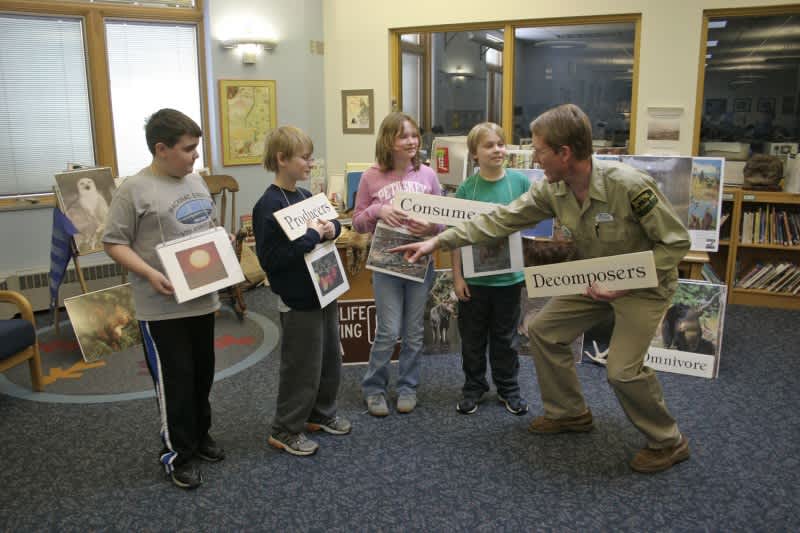Michigan Students Enjoy Mackinac Experience in the Classroom
OutdoorHub 12.21.11

For Jeff Dykehouse, curator of natural history at Mackinac State Historic Parks, holding a mounted beaver in one hand and an animal skull in the other isn’t strange – it’s just another day at the office. The mount and skull are just two props he uses to help illustrate the cycle of nature during his high-energy presentation, “Water, Woods and Wildlife.”
Throughout the fall and winter, Dykehouse travels to schools throughout northern Michigan with his interactive road show, augmenting teachers’ curriculum to help children learn about the impact they can have on Michigan’s natural environment.
“I try to get kids excited about this,” said Dykehouse. “To many of them, natural history is not as exciting as playing video games. If I can just get them more excited, I think they’ll want to learn more about natural history, and the more they learn about it the more they’ll want to protect and preserve it. That’s my ultimate goal.”
With two large boxes full of props (including mounts, animal skulls, birdcalls and posters), Dykehouse will explain the differences between carnivores, herbivores and omnivores as well as the roles of decomposers, producers and consumers in the food chain and the food cycle.
During the hour-long program, four volunteers each hang a photo of the sun, a plant, a deer or a coyote around their necks to demonstrate the structure of a food chain. Students learn to identify the difference between the “swoosh” of a goose feather and the silence of an owl’s.
Students also learn about the Great Lakes’ watershed and the many ways that it interconnects with the animals of Michigan, compare the size and depth of the Great Lakes, view a satellite photograph of the region, and experience the look and feel of mounts, pelts and skulls of the many animals that depend on the watershed for life.
“Many students don’t realize how lucky we are to live in the middle of the Great Lakes and how valuable fresh water is,” Dykehouse said. “In the future, we will all come to the conclusion that our most valuable natural resource is fresh water.”
“Water, Woods and Wildlife” is one of two programs offered by Mackinac State Historic Parks (MSHP) in its 24th season of education outreach. The second program, “Historic Mackinac on Tour,” focuses on early Michigan fur-trade history in the Straits of Mackinac and features presenters dressed as French voyageurs, British redcoats and other historic characters.
Not limited to just northern Michigan, the “Historic Mackinac on Tour” program reaches large numbers of students in Detroit, Lansing and Grand Rapids – bringing the Straits of Mackinac to the classroom with costumes, props, music, dancing and other interactive and educational elements.
“We make history come alive,” said Jim Evans, Mackinac State Historic Parks (MSHP) program presenter. “It’s a different way of teaching students than just using textbooks.” Evans, who plays a British redcoat during presentations, is also the lead interpreter at Colonial Michilimackinac in Mackinaw City.
The hour-long “Historic Mackinac on Tour” program introduces students from across Michigan to Mackinac history through interactive and entertaining activities. Students learn about the fur trade by trading a bale of fur for a woolen blanket coat. A few brave student volunteers can try on authentic period clothing and then lead the class in the group paddle dance, where two students join hands and skip between rows of their peers while fiddle music plays. Other high-energy activities include fire starting with flint and steel and, if permitted, the firing of a musket outside.
“During this age, the kids are wide-eyed and full of wonder,” said Dennis Havlena, program presenter and French fur trader. “The kids are thinking they’ll get a history lecture, but we come in with a trunk full of fiddles, furs, bagpipes, clothing to dress up in, flint and steel to light fires, and we expose them to one thing after another. You can’t find a wandering eye among them.”
Havlena created the program in 1989 and has more than 31 years of experience with the parks, including many years as the lead interpreter at Fort Mackinac on Mackinac Island.
The musical time bridge between songs is also demonstrated during the program on a historic musical instrument commonly called the jaw harp. Havlena begins by playing a song from the mid-1700s called “The Rose Tree.” By the mid-1800s, the tempo sped up and the song became known as “Turkey in the Straw.” By 2008, the song had eventually evolved into a song well-known by many children and adults today, “Do Your Ears Hang Low?”
“It’s the same song as ‘The Rose Tree,’ ” Havlena said. “It’s the same melody. I present the musical time bridge to make the connection between past and present. I relate something they know well to something they don’t recognize, and that connection is made.”
Nearly 200,000 students from across Michigan will have participated in MSHP’s education outreach programs by April 2012. Recognizing the financial strain many school districts are facing, the programs are partially funded by Mackinac Associates, a non-profit friends group that supports MSHP’s programs.
For more information about Mackinac State Historic Parks and its education outreach programs, visit www.mackinacparks.com or call (231) 436-4100.

